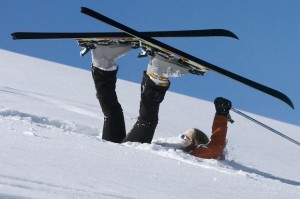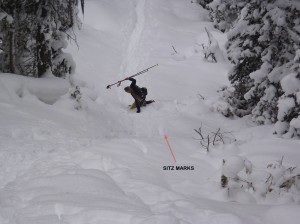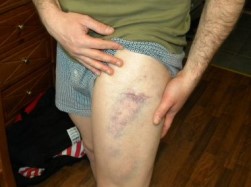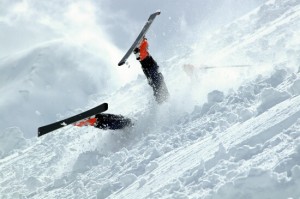“Know the Code!” Around most ski areas today you’ll see signs that define a Code of Conduct for skiers and riders. But even before there was lift-served skiing there was a Code of Conduct for skiers. Some of the elements of the original code are still present in today’s code such as “the person ahead of you has the right-of-way”. However one item in the old code that’s no longer with us is “always fill in your sitzmark!”
 It’s probably obvious, but a “sitzmark” is the German/Austrian term for the hole or depression you make in the snow when you fall. Or maybe I should say when you fall in soft snow!
It’s probably obvious, but a “sitzmark” is the German/Austrian term for the hole or depression you make in the snow when you fall. Or maybe I should say when you fall in soft snow!
Sitzmarks take us back to a time when there were few skiers and lots of snow! A fall could make a large crater in the snow. If not repaired, the next skier along could have their skis dive into the hole producing another fall which might result in injury, broken skis, or an even bigger sitzmark. The equipment and ski-technique of that era did not provide enough control to avoid such hazards.
Correct answers for last week’s trivia came from several sources. On my blog Joan Laundon was the first although she had a typo in the spelling. Lyndall Heyer provided the correct spelling. Roger Mason, Frank Kinslow, and Glen Findholt responded via Facebook. Ken Duclos and Art Lloyd provided their answers in person.
 Here in the United States early skiers also referred to sitzmarks as “bathtubs.” That seemed to be the popular term here in Stowe. Frank Springer-Miller in an early-1940s letter to Sepp Ruschp recommended adding signage on the single chair lift towers which would include “Fell in Someone’s Bathtub. Think I’ll Fix Mine From Now On!” Other documents from the early days mention that “bathtubs” on the Nosedive remain a problem – we’ll talk more about that later.
Here in the United States early skiers also referred to sitzmarks as “bathtubs.” That seemed to be the popular term here in Stowe. Frank Springer-Miller in an early-1940s letter to Sepp Ruschp recommended adding signage on the single chair lift towers which would include “Fell in Someone’s Bathtub. Think I’ll Fix Mine From Now On!” Other documents from the early days mention that “bathtubs” on the Nosedive remain a problem – we’ll talk more about that later.

Bruise
But first, whatever happened to sitzmarks and bathtubs? Grooming, snowmaking, and heavy skier traffic have produced a surface that is pretty much impervious to sitzmarks. Falling today on the slopes rarely dents the surface. However it may leave a dent in you! So now a sitzmark is probably that black-and-blue bruise on your hip from falling on Nosedive!
Going back to those early days before lift-served skiing, skiers used intentional falls to avoid worse situations. As I mentioned, equipment and technique had not advanced to allow the control we have today. Trails were narrow and contained  sharp turns. Throwing yourself down into soft snow was far better than taking on a maple tree. Some skiers used this technique for the seven turns on the old Nosedive much to the consternation of better skiers. Hence the concern about too many bathtubs on the Nosedive. Another sign Frank Springer-Miller suggested was “Do I Really Belong on the Nosedive?”
sharp turns. Throwing yourself down into soft snow was far better than taking on a maple tree. Some skiers used this technique for the seven turns on the old Nosedive much to the consternation of better skiers. Hence the concern about too many bathtubs on the Nosedive. Another sign Frank Springer-Miller suggested was “Do I Really Belong on the Nosedive?”
Falling is a part of skiing. That first time you put on skis there’s the fear of falling. You click into your bindings and ka-thump – well, that wasn’t too bad after all. Usually during the learning process there are a lot of falls, but few injuries, and the fear subsides. Next is the counting-falls stage where how many times you fall in a day becomes a measure of progress. We’ve all heard the proud cries of “I only fell twice today!” Then there’s the rationalization stage: “If you’re not falling, you’re not advancing.”
For those who persevere and become expert skiers, falls become rare, but they still occur. One thing I have noticed as a “mature” expert skier who doesn’t fall often is that some of that fear of falling creeps back in. When I get in dicey situations, I feel myself tensing up just like those beginners. I have to force myself to stay loose and handle the situation. For those who witnessed my bad fall earlier this season, I didn’t have time to tense up which was probably a good thing!
 Another aspect of falls or near-falls is that they provide the memorable moments that we can re-live at après-ski or even years later. We may not remember the perfect turn we executed on the early morning corduroy, but we remember the yard sale under the Warm Springs lift at Sun Valley.
Another aspect of falls or near-falls is that they provide the memorable moments that we can re-live at après-ski or even years later. We may not remember the perfect turn we executed on the early morning corduroy, but we remember the yard sale under the Warm Springs lift at Sun Valley.

1 Pingback